Monogram 1/48 F-80 "The Beer City Special" – 36th FBS, 8th FBW, Korea 1951
The Airplane:
The technological revolution in aircraft design and operation that resulted from the successful development of jet engines brought about more technological change in the five years between the end of World War II and the Korean War than any other comparable time in the history of aviation from the Wright Brothers' first flight. Supersonic flight was achieved a bit more than two years after the end of the war and the first fighter capable of controlled transonic flight saw action in Korea.
When the first USAAF jet fighter, the P-59, was a demonstrated operational failure by early 1943, the USAAF turned to Clarence “Kelly” Johnson and Lockheed to create a solution. The situation was made more urgent by the recent discovery through aerial reconnaissance of the existence of the German Me-262 fighter, which appeared ready to enter service within the next year. The Air Force had been provided with the newly-designed Halford H-1B engine, which would become known as the “Goblin.” Time was of the essence. Kelly's special secret design unit which combined design and engineering personnel for the rapid creation of prototypes, already known as “The Skunk Works,” presented a concept for a single-engine air superiority fighter in April 1943. A design specification written around the proposal was issued n May, 1943; Lockheed presented its detailed proposal for Project MX-409 30 days later. A contract for a single prototype was signed on June 17, 1943. Final design and production commenced on June 26. The project was so secret only the five managers of the 130 people working on it knew they were working on a jet aircraft. Security was so high the British engineer who delivered the Goblin engine that fall was detained by police when Lockheed officials could not vouch for him. The prototype, known as “The Green Hornet” for its RAF dark green paint scheme and nicknamed “Lulu Belle,” was trucked to Muroc Field from the Lockheed factory in Burbank on November 16, 143 days after commencement of work. The engine was mated to the airframe, only to be destroyed by foreign object damage during the first run-up. There was only one other Goblin engine in existence, which delayed the first flight until it could be removed from the first deHavilland Vampire prototype and delivered from Britain.
The prototype, now known as the XP-80, was displayed to Air Force commanders at Muroc on January 8, 1944. Lockheed Chief Engineering Test Pilot Milo Burcham made the first flight. The jet roared down Muroc's Runway 23, lifted off, then quickly landed when the landing gear failed to retract. Lockheed's technicians quickly fixed the electrical problem; Burcham started up again and soared into the clear California winter sky. Over the next hour, he gave an air show in which he demonstrated the wonderful flying characteristics the P-80 was known for in service.
The XP-80A was designed for the larger General Electric I-40 engine (an improved J31, later produced by Allison as the J33). Two aircraft, 44-83021 and 44-83022, were built to test this configuration. 44-83021 was nicknamed “The Gray Ghost” for its "pearl gray" paint scheme, while 83022 was left unpainted for comparison of flight characteristics and became “The Silver Ghost.” The XP-80As' airframe was larger and 25% heavier than the XP-80. Initial opinions were not positive. Burcham commented after several flights that an aircraft he very much enjoyed when powered by the Halford engine had become a "dog." Further tests revealed the engine was not getting enough air to produce full power. Modification to the air intakes to improve boundary layer control resulted in the engine maintaining full power, restoring the flight characteristics of the Green Hornet.
On October 20, 1944, Burcham was killed in the third YP-80A (44-83025) when the engine flamed out on takeoff due to fuel starvation. His death resulted from the failure to brief him on a newly installed emergency fuel pump backup system that would have prevented the failure. On March 25, 1945, newly-promoted Chief Engineering Test Pilot Tony LeVier was forced to bail out of The Gray Ghost when one of the engine's turbine blades broke and caused a structural failure in the aircraft's tail. LeVier broke his back when he landed hard and only returned to the test program six months later.
On August 6, 1945, Major Richard Bong, the top-scoring USAAF ace, was killed during the acceptance flight of a production P-80 when the engine failed on takeoff as had happened to Burcham. When the aircraft rolled inverted, Bong bailed out but he was too close to the ground for his parachute to deploy. The investigation found he had forgotten to switch on the emergency fuel pump, which could have prevented the accident. The pre-takeoff check-off list was changed to insure the pilot turned on the emergency pump before engine start-up.
Lockheed eventually built a total of 917 F-80As and Bs. These were followed by the P-80C, which began production in 1948; its designation changed on June 11 to F-80C when the newly-independent Air Force changed designators to F-for-fighter rather than P-for-pursuit. This sub-type differed from the P-80A and B in having a wing of thinner section and a more powerful Allison J33-A-35 giving 4,600 lb S.T. dry thrust, which could be increased to 5,400 lb S.T. with water injection. Top speed increased to 594mph (Mach 0.76) at sea level and rate of climb increased to 6,870 fpm. The F-80C was also the first Air Force fighter to have an ejection seat installed at the factory. Production ended in 1950 with 162 P-80C-1-LO, 75 P-80C-5-LO and 561 F-80C-10-LO production blocks in addition to 129 F-80As upgraded to F-80C-11-LO standard.
The F-80 in Korea:
When war came in Korea with the invasion by North Korea on June 25, 1950, the American forces in Japan were far from ready for combat. The 51st Fighter Group had been operating the F-80 since the end of 1948, while the 8th Fighter Group had only recently converted to the F-80 from F-51 Mustangs. At the outbreak of war, a substantial number of F-80s could not carry either wing-tip tanks or bombs.
US Forces were authorized to entire combat by President Truman on June 26, 1950. There were no forward airfields in Korea that could handle jet aircraft, which meant the F-80s had to fly from Itazuki AFB on Kyushu, and had an effective loiter time of only 20 minutes over the 38th Parallel, the point of invasion. The Misawa tanks that were quickly produced by adding an extra section to the existing tank, were heavy enough that some aircraft eventually suffered wing failure.
The 8th Fighter-Bomber Group:
Based at Suwon in South Korea from the summer of 1951, the 8th Fighter Bomber Wing, composed of the 35th, 36th, and 80th Fighter Bomber Squadrons, was the longest serving F-80 unit in Korea, flying the Shooting Star until May 1953, when it converted to F-86 Sabres.
On June 27, 1950, the 8th Fighter Bomber Wing launched four 35th FBS F-80s, flown by 1st Lieutenants Robert Dewald, Ralph Hall, Robert Wayne led by Captain Ray Schillereff, to patrol Kimpo Airfield at Seoul while General MacArthur flew into Kimpo for a first-hand look at the situation.
North Korean Il-10 aircraft flew over Kimpo at low level. While there is no dispute that the 35th FBS got the USAF's first jet kill, there is dispute over who actually got that kill.
According to “Crimson Sky: The Air Battle for Korea,” 1st Lt Robert Wayne, covered by his wingman 1st Lt Ralph Hall, shot down the first two Il 10s, with CAPT Ray Schillereff and 1st Lt Robert Dewald picking off one each of the fleeing bombers. Other sources say Schillereff and Dewald were the first victors, which demonstrates just how fast the fight happened.
The first fighter bomber missions were launched on June 28, 1950. These were armed reconnaissance missions aimed at blasting moving columns of enemy equipment, supplies, and personnel. They were not particularly effective at first, due to the fact the 8th's pilots did not have training in ground attack to operate effectively. Over the next two and a half years, of the 277 F-80s lost in operations - approximately 30% of the existing inventory - 113 were destroyed by ground fire and 14 were shot down by enemy aircraft.
As is pointed out in “Crimson Sky,” “...F 80 pilots felt they were doing the dangerous interdiction work but receiving no credit... As a result, fighter bomber units took greater pride in unit accomplishments versus the individual pilot accomplishments. Squadrons had special baseball caps and beer steins made. Each squadron custom designed and ordered its own cap from Japanese manufacturers. The squadron logos in Korea were emblazoned on caps, signs, beer mugs, jackets, and flight suits.”
The operational life of a fighter bomber pilot was hazardous and often short. 147 Air Force aircraft were lost in air-to-air combat; by comparison, over 816 aircraft were shot down by ground fire. As Raymond Sturgeon, a pilot with the 35th FBS, put it, "I had friends in F-86s who never saw a MiG their entire tour, but we got fired on every mission with high powered guns that shot golf balls at you." The 35th FBS lost "a pilot or two" every week, and losses like these were not unusual in the Wing.
The F-80 had more than a few bugs. It needed an elaborate water injection system just to take off from the short runways in Japan and Korea. Water injection worked like a primitive after burner: water was injected into the combustible mixture, giving it 300-400 more pounds of thrust. However, this system could frequently fail. Additionally, when fully loaded with drop tanks and up to 2,000 lbs of bombs, the F 80 could not get airborne without JATO, and these units were also prone to failure. As one pilot remembered, every combat takeoff was “an adventure.” Additionally, the wing tanks also had a propensity not to feed well. On top of all this, the airplane had never been designed for the ground attack role, and had no additional armor protection for the pilot or any critical system, making the F-80 very vulnerable to ground fire, which pilots faced on every sortie.
The Kit:
Monogram's F-80 Shooting Star was first released around 1976, part of a trio of Korean War jets, the others being the F-86F Sabre and the MiG-15bis. 47 years later, Monogram's now-ancient kit is still the only accurate F-80 kit available in 1/48. In 2017, Hobby Boss released an F-80 kit that is completely botched by air intakes that are 25% too large, as well as other dimensional inaccuracies. The Monogram kit is outline accurate, and within an 1/48th of an inch of “on the nose” in both length and wingspan.
The kit is from that maddening period when Monogram was owned by a company that made car kits, whose CEO had so little understanding of airplane kits that he believed withdrawing the P-51B from production would result in more sales of the newer P-51D, since “A P-51 is a P-51.” The F-80, F-86 and MiG-15 were “produced for a price,” and it shows in poor fit of parts and decals that are cheap, thick, inaccurate and overall unusable in all varieties of the kits that have ever been released.
Fortunately, SuperScale and Aeromaster released several F-80 aftermarket decal sheets that are quite accurate and allow a modeler to do everything from the early P-80As through the F-80C. They still show up on eBay at reasonable prices, which is where I found Aeromaster 48-658, which allowed me to do “the Beer City Special,” an F-80C of the 36th FBS of the 8th FBW I ad long wanted in the collection for the “mouth” markings.
Construction:
I decided to do this when I walked into the LHS and found the kit on the Estate Sale shelves for $20, after finding the decal sheet a week earlier for $20 delivered.
The kit is old-school simple with around 40 parts, of which about 37 are used depending on which sub-type one is making. If you treat the kit as a limited-run project and are careful in cleaning up the parts and assembling them, you can finish the assembly without using filler other than on the fuselage centerline.
I began by attaching each rear fuselage half to the forward fuselage half. Once the Tamiya Extra-Thin cement had set up, I reinforced the joints on the inside with CA glue. I then attached the intakes and their splitter plates to each fuselage half, and finished by gluing the open gun bay door on the left side closed.
I then cut off the tabs on the dropped flaps and glued them to the lower wing in the closed position. I reinforced this joint with some Evergreen sheet on the inside, and filled the gaps between the flaps and the wing inboard and outboard with CA glue applied from inside.
I then painted and detailed the cockpit tub and attached it. I filled the nose with fishweights and then attached the engine to the right fuselage half. I finished off by assembling the fuselage; I cut off the locating pins so I could carefully get the best fit possible.
The wing was then attached to the fuselage, and the horizontal stabilizers were attached. When all had set up, I filled the fuselage centerline and wing/fuselage gaps with CA glue. When that was set, I engaged in an afternoon-long sanding and smoothing process, using around 10 different sanding sticks of varying grit to get the model as smooth as possible, then put about 20 minutes into polishing it overall, re-sanding with fine grit pads wherever I came across scratches, till all was smooth. I then rescribed the raised panel lines with a #11 blade.
Painting and Markings:
I first misted on a thinned coat of Tamiya X-18 Semi-Gloss Black as a primer for the Vallejo metal paint to grab. Color photos of F-80s reveal the airplane was primarily one type of aluminum, with some various panels in a lighter shade. I painted the model overall with Vallejo Aluminum, then airbrushed the center area of the wing with White Aluminum, then the gjun bay covers and other panels with Semi-Matte Aluminum.
Markings:
I used the excellent Fundekals National Insignia sheet (highly recommended - every version of US national insignia from 1943-65, properly proportioned in the correct colors) for the stars and bars. The Aeromaster decals worked without problems other than I had to soak them longer to bring them off the backing without breaking.
Final Finish and Assembly:
I glued the clear canopy to the silver frame using Micro Krystal Klear white glue, which filled the gaps and dried invisible. The seat was finished using Eduard photo-etch seatbelts and installed, with the canopy positioned open. I attached the main gear and the underwing bomb pylons.
Overall:
Success with this kit requires dusting off and applying some WD-40 to the Old School Modeling Skills, which are definitely needed. This was a nice trip in the Wayback Machine to recall how lucky we are today with modern kits. The old kit can still be turned into a nice addition to your Korean War collection.

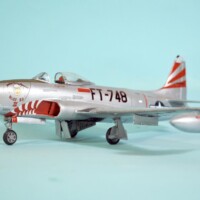
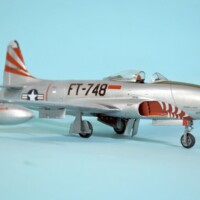
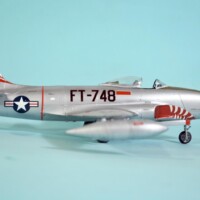

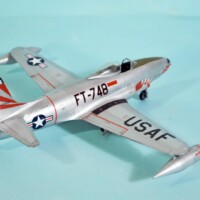
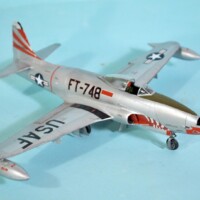
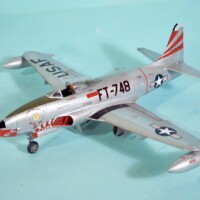
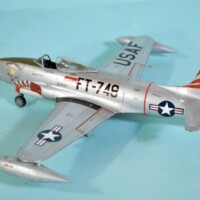
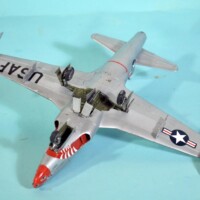
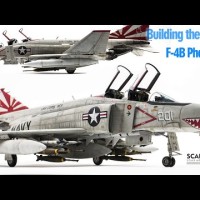
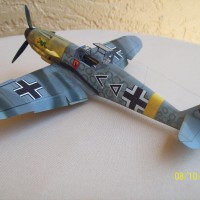
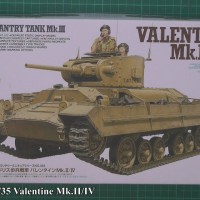

Fantastic Painting and decaling!
I always enjoy updating and building these older kits without modern replacements. There's something inherently satisfying in turning a basic kit into a very good looking replica. This is an excellent result and the history was very interesting.
Thanks for the informative article, and a beautifully built kit. I have this kit in the stash along with the F-86. For a model car manufacturer not really caring about aircraft too much, Monogram seamed to have gotten the shapes and proportions right on most of their airplane kits. I think I still have the P-51B and D kits still too. I know the newer kits are easier to build but theres something about building the old kits that I really enjoy. Maybe it's just because their mostly correct, and just need a little attention to bring them up to todays standards.
The P-51B and D are two that are really outdated. The D can be "brought up" with a lot of work and some aftermarket sets (vacuform canopy and the True Details P-51D cockpit) but the B has problems that no amount of "some modeling skill required" can really solve.
Great result Tom. One in the stash
Jets of this era are so cool and this one’s no exception.
Nice work on one of my least favorite kits, Tom. I built one way back when and it was disappointing. You’ve posted a few of these and have proved it can be built with a good result. I need to take the plunge and pull mine out of deep storage and take a crack at it. The F-80 is one of my favorite planes and it’s also the biggest gap in my KW collection.
Take care in assembly and all is well with the kit.
Love the history about the bird. I remember going to the drug store-yes they carried models then- and buying the Monogram kits for $1.25. Seemed like a fortune to me then.
Well, you know I love that old Monogram F-80 kit, Tom @tcinla, and posted my version, "Salty Dog", here, many years ago. Obviously, those kits can produce a very creditable model plane and you've demonstrated that quite well with "The Beer City Special". Thanks also for the great history to go with it too! 👍
I still keep some o' that WD40 in my modeling kit! Comes in handy from time to time...
Excellent result on this oldie, Tom! I loved reading all the historical facts!
Great to see another Monogram classic crafted into a fine display.
Really great build of an old kit and a great story to boot. As an old A-10 air-to-ground pilot, I'm glad you addressed the BIG difference between air-to-air and air-to-ground operations. The air-to-air guys seem to get all of the glory...though many NEVER ever see a bad guy...while air-to-ground types get down in the mud and get hammered each mission. It is a tough job, but doesn't play as well in the "propaganda machine"...a fact you addressed in your book "MiG Alley".
Lastly, I'm happy to see that someone else uses Vallejo Metallic paints besides me. The produce a very nice finish and are so easy to use.
I am totally sold on Vallejo. Nobody else is even close.
Beautiful work, Tom, very helpful tips, and engrossing history. Many thanks!
Nice result on that old kit. Those old Monogram kits can be made to look really nice with enough WD-40. You nailed it!
Thanks a lot for the historical facts, Tom @tcinla
And as well for treating us with this beautiful F-80.
Very nice scheme.
Very nice.
@tcinla - Tom... wow... what an amazing writeup and kit review. Love the reference to the way-back machine, Professor Peabody would be proud! Amazing build, paint and weathering. One would never know that this wasn't a modern kit based on your results.
Really nice model, Tom (@tcinla). I didn't know you still dabbled in old school stuff. The NMF came out great. I always figure that when you build an old kit like this, it is like saving an old dog at the animal shelter. Still a lot of life in these old kits when you put in a little extra effort. Well done.
Or an old cat. 🙂
This turned out really nice. Too bad the supposed update HobbyBoss had too many glitches.
A very beautiful build! As i saw the first picture my initial tought was that it was somehow painted in a japanese look and then when i read the article it made sense.
Excellent build and narrative Tom. Like others have said the Monogram F-80 is a favorite. I too have built a number of them over the years, 2 at the same time most recently. Two Thumbs Up!
Still a fantastic result with such an old kit, my compliments.
Nice read as well!
Nice job, Tom!
Beautiful work Tom (@tcinla). I hadn't realized you were doing this when you commented recently on my own Monogram F-80 build in the Aircraft IN Progress group. But yours looks far better than mine. Excellent historical narrative as well. I always enjoy seeing your build articles.
@clipper - Don't put yours down, Carl. You did good work and got a great save there.
Looks great! You man-handled her into shape nicely.